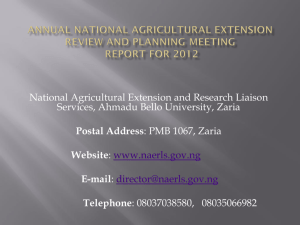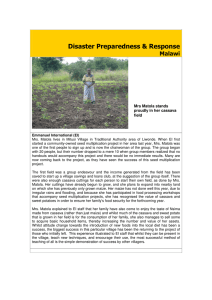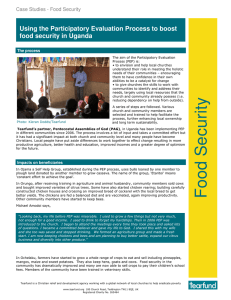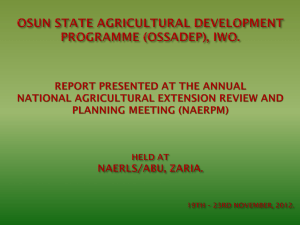MICROECONOMICS TECHNICAL PAPER, SUMMER 2011
advertisement
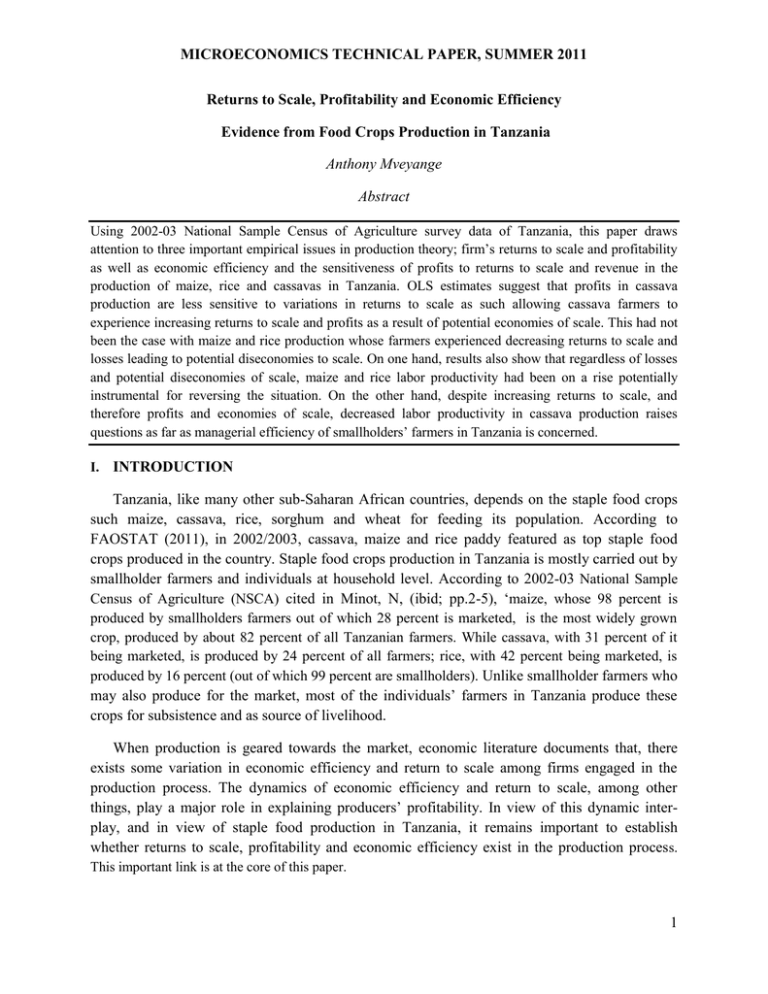
MICROECONOMICS TECHNICAL PAPER, SUMMER 2011 Returns to Scale, Profitability and Economic Efficiency Evidence from Food Crops Production in Tanzania Anthony Mveyange Abstract Using 2002-03 National Sample Census of Agriculture survey data of Tanzania, this paper draws attention to three important empirical issues in production theory; firm’s returns to scale and profitability as well as economic efficiency and the sensitiveness of profits to returns to scale and revenue in the production of maize, rice and cassavas in Tanzania. OLS estimates suggest that profits in cassava production are less sensitive to variations in returns to scale as such allowing cassava farmers to experience increasing returns to scale and profits as a result of potential economies of scale. This had not been the case with maize and rice production whose farmers experienced decreasing returns to scale and losses leading to potential diseconomies to scale. On one hand, results also show that regardless of losses and potential diseconomies of scale, maize and rice labor productivity had been on a rise potentially instrumental for reversing the situation. On the other hand, despite increasing returns to scale, and therefore profits and economies of scale, decreased labor productivity in cassava production raises questions as far as managerial efficiency of smallholders’ farmers in Tanzania is concerned. I. INTRODUCTION Tanzania, like many other sub-Saharan African countries, depends on the staple food crops such maize, cassava, rice, sorghum and wheat for feeding its population. According to FAOSTAT (2011), in 2002/2003, cassava, maize and rice paddy featured as top staple food crops produced in the country. Staple food crops production in Tanzania is mostly carried out by smallholder farmers and individuals at household level. According to 2002-03 National Sample Census of Agriculture (NSCA) cited in Minot, N, (ibid; pp.2-5), ‘maize, whose 98 percent is produced by smallholders farmers out of which 28 percent is marketed, is the most widely grown crop, produced by about 82 percent of all Tanzanian farmers. While cassava, with 31 percent of it being marketed, is produced by 24 percent of all farmers; rice, with 42 percent being marketed, is produced by 16 percent (out of which 99 percent are smallholders). Unlike smallholder farmers who may also produce for the market, most of the individuals’ farmers in Tanzania produce these crops for subsistence and as source of livelihood. When production is geared towards the market, economic literature documents that, there exists some variation in economic efficiency and return to scale among firms engaged in the production process. The dynamics of economic efficiency and return to scale, among other things, play a major role in explaining producers’ profitability. In view of this dynamic interplay, and in view of staple food production in Tanzania, it remains important to establish whether returns to scale, profitability and economic efficiency exist in the production proces s. This important link is at the core of this paper. 1 MICROECONOMICS TECHNICAL PAPER, SUMMER 2011 Maize, cassava and rice are the main staple food in Tanzania. For-example, Minot, N, (2010: 2) argues, ‘the per capita consumption of cassava (157 kg per capita) is twice that of maize (73 kg per capita)’. In the context of nutritional ingredients, Minot (ibid) further claims, ‘because of its greater caloric density, maize is more important as a source of calories, contributing 33 percent of the total compared to 15 percent for cassava’ suggesting Tanzanians’ more dependence on maize for food consumption than cassava. Also important are rice, wheat, and sorghum, each representing 4-8% of the caloric intake. Under the assumption that smallholders allocate their inputs and output efficiently, economic theory dictates that they will, eventually, make profit (or at least they will not sustain losses) suggesting that if they are inefficient their ability to generate profits is constrained and hence vulnerable to making losses. The objective of this paper is three folds; first, to estimate the elasticity of profits to returns to scale; second, to explore whether or not returns to scale and profits exist in the production of maize, rice and cassava in Tanzania. Finally, to analyze whether or not Tanzania’s smallholder’s farmers engaged in maize, cassava and rice production are economically efficient in terms of their unit cost and labor productivity. Empirical results suggest that profits in cassava production are less sensitive to variations in returns to scale as such allowing cassava farmers to experience increasing returns to scale and profits as a result of potential economies of scale. This had not been the case with maize and rice production whose farmers experienced decreasing returns to scale and losses leading to potential diseconomies to scale. On the one hand, results also show, regardless of losses and potential diseconomies of scale, maize and rice labor productivity had been on a rise potentially instrumental for reversing the situation. On the other hand, despite increasing returns to scale, and therefore profits and economies of scale, decreased labor productivity in cassava production raises questions as far as managerial efficiency of smallholders’ farmers in Tanzania is concerned. The remaining five sections of the paper are organized in the following order: Section II reviews important literatures. While Section III covers theoretical framework, section IV cover data and estimation respectively. Finally, results and conclusions are covered in section V and VI respectively. 2 MICROECONOMICS TECHNICAL PAPER, SUMMER 2011 II. LITERATURE REVIEW Literatures on economic efficiency, return to scale and firm’s profitability are very rich and diverse. Most notable works include: Farrel and Fieldhouse (1962); Lau and Yotopoulos (1971); Takayama (1993); Basu and Fernand (1997); and Ackerberg, et all, (2005). Traditionally, production functions are estimated to evaluate the productive and economic efficiency and profitability of firms and in aggregation of an industry as Ackerberg A.D,et all, (2005), asserts, ‘production functions are fundamental components of all economics’, typically, they relate productive inputs (e.g. capital, labor, materials) to outputs. As an extension to the traditional practice, Nevo A, (2009: 2) outlines, among others, such reasons as: evaluating increasing returns to scale; economies of scale and scope; factor inputs substitutability and complementarities, and productivity analysis being motives behind estimating production functions. Worthy of note, also is work by Snyder and Nicholson (2008: 302). Their main proposition lies in the heart that production function are characterized by analyzing how output ‘responds to increases in all inputs together’ commonly known as returns to scale1. They also bring to bear an important insight that as much as returns to scale may increase efficiency through division of labor and specialization, it is also associated with loss in managerial efficiency because of difficulty of exercising managerial overseeing. In addition, there have been a number of studies investigating the variation of returns to scale across firms. An important piece of work in this regard is by Kumbhakar C.S, et all, (1991). The summary of their main argument hinges on the fact that ‘if efficiency and return to scale (RTS) vary across farms, those with lower return to scale and relatively more efficient will be more profitable2. Similarly, a firm is said to be technically efficient if maximum possible output is obtained given the input quantities. In general, economic literature holds that, in order to ensure firm achieve optimum results, neo-classical theory of production theorizes that a profit maximizing firm is economically efficient in resource allocation if optimality conditions are fully satisfied. In addition to the fundamentals of neo-classical theory, Takayama (1993:157), points out that understanding how returns to scale and its variants is unquestionably important for studies ‘involving scale economies and diseconomies’. This literature exposition is the basis of the theoretical model developed in section III of this paper. 1 If the production function is given by and if all inputs are multiplied by the same positive constant t (where t >1) then we can have constant, decreasing and increasing returns to scale (Snyder and Nicholson, ibid: 302) 2 The argument is derived from the relation where P=output prices, Y=output 3 MICROECONOMICS TECHNICAL PAPER, SUMMER 2011 III. THEORETICAL FRAMEWORK The model used in this paper basically borrows ideas from Takayama (ibid: 157), Basu and Fernald (1997:253) and Kumbhakar C.S, et all, (ibid). Together with the standard CobbDouglas production function the following are assumed to hold; farmers in Tanzania are smallholders who majority own land. Capital is assumed to take the form of input materials (mainly fertilizers) for production. Whereas, land is assumed to be freely available, in-elastically supplied, arable and productive, labor and materials are assumed to be variable and fixed respectively. Farmers are also assumed to allocate inputs and output efficiently so much so that competitive conditions are satisfied. The production function is therefore given as ; transforming it into logarithms becomes ; Where Q is firm’s total output; L is labor; M is materials such as fertilizers; is an error term which according to Nevo A, (ibid) includes, technology or management differences, measurement errors and variation in external factors; , and are parameter estimates. According to Takayama (ibid: 157) and Basu and Fernald (ibid: 253) cost function is obtained by the usual cost minimization procedure and is given as ; Where C is firm’s total cost; ; is fixed input price vector; w is fixed labor wage; n average fixed cost of materials (mainly fertilizers); Q is output and M is materials. It follows therefore, Where defines returns to scale. Economic literature holds that if increasing returns to scale (IRS) exist, if and then ) then decreasing returns to scale (DRS) and constant returns to scale (CRS) do exist respectively. To clearly link returns to scale to firm’s profitability the paper uses the profit relation used by Kumbhakar C.S, et all, (ibid: 279) given as follows; ; Where p is output price, Q is output and is returns to scale. As Kumbhakar C.S, et all, (ibid: 279) asserts, the underlying assumption behind this result is that smallholders farmers allocate 4 MICROECONOMICS TECHNICAL PAPER, SUMMER 2011 inputs and output efficiently. Equation (5) clearly indicates that if i.e. IRS, DRS and CRS then profits will increase, decrease or remain constant respectively as output changes. Assuming profits are non-negative; Equation (6) shows that there is IRS and profits when and zero profits if IV. ; DRS and loses if CRS . The elasticity of profit to RTS in (6) is then estimated using (7); DATA AND ESTIMATION Data sources used for empirical analysis of this study were obtained from 2002-03 National Sample Census of Agriculture (NSCA) survey data in Tanzania in which data on output, sales and input (labor and materials) usage by smallholders’ farmers were analyzed. Input and output prices for 2002-03 were obtained from FAOSTAT (2011) and LABORSTA (2011) databases. For estimation purposes, the paper uses average annual input and output prices for 2002-03. This paper uses OLS to estimate (7) - a monotonic transformation of (5) - for smallholders producers of maize, cassava and rice in Tanzania. OLS method is employed primarily to draw attention to profits sensitiveness3 to revenue and RTS variation; and to link inferences-based on mean estimation- of relation (4) and (5) as to the existence of returns to scale and profitability. Local polynomial smoothing is then used for estimating the shape of average productivity of labor and average cost per unit as both labor and output changes marginally. V. (i) RESULTS Profitability Sensitiveness to RTS and Revenue Table 1: OLS Regression Estimates for Profit Elasticity Maize Rice Coef. Std. Err. t-stat Coef. Std. Err. t-stat Profits TR 1.002871 0.0070401 Phi -0.2428455 0.456456 RTS -0.0008634 0.000592 Constant -17.7518 0.5458707 Adjusted R-Square 0.9876 3 142.45 -0.53 -1.46 -32.52 0.979988 0.036239 -0.00098 -17.2464 0.0055027 0.4226399 0.0011982 0.4815542 Coef. Cassava Std. Err. t-stat 178.09 1.041338 0.023257 44.78 0.09 0.0022513 0.0023246 0.97 -0.82 1.764223 1.454263 1.21 -35.81 -18.97561 0.8120465 -23.37 0.9959 0.9802 Since (7) is in logarithmic form then its coefficient estimates are measures of profit elasticity. 5 MICROECONOMICS TECHNICAL PAPER, SUMMER 2011 Table 1 suggests that profits from both maize and rice had been sensitive to variations in returns to scale unlike cassava’s profits which seem to have had been less sensitive. However, with exception to Rice’s profits for which results suggest it had been sensitive to revenue variations, Maize and Cassava seem to had been less sensitive. In connection to equation (6), Table 1 estimates indicate that cassava had experienced increasing returns to scale (and therefore profits) while Maize and Rice had experienced decreasing returns to scale (and therefore losses). (ii) Returns to Scale and Profitability Table 2: Mean estimates for Returns to Scale and Profitability Maize Rice Cassava Variable Coef. Std. Err. Coef. Std. Err. Coef. Std. Err. Profits 12.01879 0.30825 19.3515 0.51014 14.0667 0.58917 RTS 0.290738 3.64149 0.00835 0.00659 -2.9094 3.57115 Extending the above analysis to equations (4) and (5), Table 2 suggests that smallholder farmers in both maize and rice had experienced decreasing returns to scale while those in cassava had increasing returns to scale. This justified the existence of profits in cassava production and losses in maize and rice production. (iii) Economic efficiency To analyze whether Tanzania’s smallholders’ farmers are economically efficient is one of the main objective of this paper. In this context dimension of economic efficiency explored include average total cost per unit and average labor productivity. Figure 1, 2 and 3 in the appendix suggest that when a degree 2 local polynomial smoothing is done ATC for maize, rice and cassava was U-shaped as quantity produced increases. Relating ATC shape to returns to scale, it is evident that smallholders’ farmers in cassava production in 2002/03 were more economically efficient as they experienced increasing returns to scale. Arguably, this suggests the existence of economies of scale in cassava production. On the contrary, the reverse seems to hold for maize and rice production which apparently experienced diseconomies of scale, signifying that smallholder’ farmers for maize and rice were economically inefficient. Analysis of APL in Figure 1.1, 2.1 and 3.1 in the appendix suggests that, while labor productivity in maize and rice production was increasing in 2002/03 it was a different story with respect to cassava. Labor productivity in the production of cassava increased moderately before starting to decreased. 6 MICROECONOMICS TECHNICAL PAPER, SUMMER 2011 VI. CONCLUSIONS On account of the fact that maize, rice and cassava were ranked as top food crops produced in 2002/03, this paper intended to draw attention to three important empirical issues; the existence of returns to scale and firm’s profitability; the analysis of how sensitive profits were to returns to scale and revenue as well as exploration of economic efficiency by Tanzania’s farmers in the production of these food crops. As results above suggest, unlike cassava farmers who experienced increasing returns to scale and profits and therefore enjoyed economies to scale, maize and rice farmers experienced decreasing returns to scale and losses leading to potential diseconomies to scale. Despite sustaining increasing returns to scale, profits and implied economies of scale, decreases in cassava’s labor productivity reflect ‘loss in managerial efficiency because of difficulty of exercising managerial overseeing4’. Potentially, decreased labor productivity might have had some effect in dragging down the increasing returns and economies of scale as well as profitability potential of cassava production in Tanzania. On the contrary, increased maize and rice productivity suggest to have had some promising outcomes in reversing potential diseconomies of scale emanating from decreasing returns to scale and losses. These two conclusions have important policy implications for agricultural sector in Tanzania. Specifically, now that the government development agenda is to foster agriculture through the KILIMO KWANZA programme. Based on the findings of this paper, the Tanzanian government can also direct its KILIMO KWANZA agenda towards food crops analyzed above to enhance food sustainability as well as creating commercial ventures to boost income of local farmers. 4 Snyder Nicholson (2008: 302) 7 MICROECONOMICS TECHNICAL PAPER, SUMMER 2011 REFERENCES Ackerberg, Daniel A, Caves, Kevin and Frazer, Garth (2005), “Structural Identification of ProductionFunctions”http://www.fep.up.pt/investigacao/cempre/actividades/macro2/adv _eco_analysis_05-06/Daniel%20Ackerberg/Ackerberg_paper_semin%C3%A1rio.pdf Accessed: 05/08/2011 16:11 Basu, Susanto and Fernald, John G (1997), “Returns to Scale in U.S. Production: Estimates and Implications”, Journal of Political Economy, Vol. 105, No. 2, pp. 249-283. Stable URL: http://www.jstor.org/stable/10.1086/262073 Accessed: 05/08/2011 00:10 FAO, (2011), “FAOSTAT”, United Nations, Rome, Italy Stable URL: http://faostat.fao.org/default.aspx and http://countrystat.org/tza. Accessed: 05/08/2011 00:03 Farrell, M.J and Fieldhouse, M, (1962), Estimating Efficient Production Functions under Increasing Returns to Scale, Department of Applied Economics, Cambridge, London, England Kumbhakar C.S, Ghosh Soumendra and McGuckin Thomas J (1991) “A Generalized Production Frontier Approach for Estimating Determinants of Inefficiency in U.S. Dairy Farms”, American Statistical Association, Journal of Business and Economic Statistics, Vol. 9, No. 3 ILO, (2011), “LABORSTA”, United Nations, Geneva, http://laborsta.ilo.org/. Accessed: 05/08/2011 10:03 Switzerland, Stable URL: Lau, Lawrence J and Yotopoulos, Pan A (1971), “ A Test for Relative Efficiency and Application to Indian Agriculture”, The American Economic Review, Vol. 61, No. 1, pp. 94-109. Stable URL: http://www.jstor.org/stable/1910544 Accessed: 05/08/2011 00:03 Minot, Nicholas, (2010),” Variation in Staple Food Prices in Eastern and Southern Africa: A Synthesis”, COMESA policy seminar on “Variation in staple food prices: Causes, consequence, and policy options”, Maputo, Mozambique, 25-26 January 2010 National Bureau of Statistics, (2003), “National Sample Census of Agriculture 2002/03 Technical Report, United Republic of Tanzania, Dar es Salaam, Tanzania Nevo, Aviv, (2009), Estimation of Production Functions, Northwestern http://faculty.wcas.northwestern.edu/~ane686/teaching/production_functions.pdf University, Snyder, Christopher and Nicholson, Walter, (2008), Micro Economic Theory, Basic Principles and Extensions, (10th ed), Thomson South-Western, Canada Takayama, Akira, (1993), “Analytical Methods in Economics”, the University of Michigan Press, University of Michigan, United States 8 MICROECONOMICS TECHNICAL PAPER, SUMMER 2011 66.08923 66.08924 66.08924 66.08925 66.08925 APPENDIX Figure 1: Local polynomial smooth for Maize ATC 0 5000 10000 Quantity Produced (kgs) 15000 66.08923 66.08924 66.08924 66.08925 66.08925 kernel = epanechnikov, degree = 2, bandwidth = 7500 Figure 3: Local polynomial smooth for Cassava's ATC 0 2000 4000 6000 Quantity Produced (kgs) 8000 10000 66.08923 66.08924 66.08924 66.08925 66.08925 kernel = epanechnikov, degree = 2, bandwidth = 7500 Figure 2: Local polynomial smooth for Rice's ATC 0 5000 10000 Quantity Produced (kgs) 15000 kernel = epanechnikov, degree = 2, bandwidth = 7500 9 838.2491 838.2491 838.2489 838.249 838.249 Figure 1.1: Local polynomial smooth for Maize APL 0 5 10 Labour 15 20 838.2491 838.2491 kernel = epanechnikov, degree = 2, bandwidth = 7500 838.2489 838.249 838.249 Figure 2.1: Local polynomial smooth for Rice's APL 0 5 10 Labor 15 20 838.2491 838.2491 kernel = epanechnikov, degree = 2, bandwidth = 7500 838.249 Figure 3.1: Local polynomial smooth for Cassava's APL 838.249 838.2489 Average Labor Productivity Average Labor Productivity MICROECONOMICS TECHNICAL PAPER, SUMMER 2011 0 5 10 Labor kernel = epanechnikov, degree = 2, bandwidth = 7500 10
